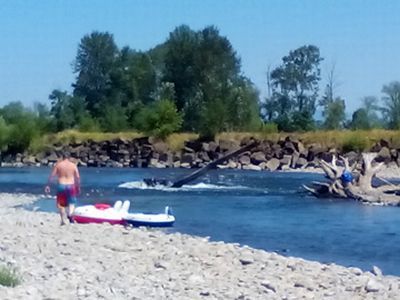
Publisher:
Bonnie King
CONTACT:
Newsroom@Salem-news.com
Advertising:
Adsales@Salem-news.com

~Truth~
~Justice~
~Peace~
TJP
Jul-24-2014 08:23

 TweetFollow @OregonNews
TweetFollow @OregonNews
Marine Board Warns of Hazards on Oregon Waterways
Salem-News.com StaffTrees, root wads and other natural debris are a common part of Oregon's rivers and streams.
 As a result of less snow pack and lower rainfall amounts this winter, many Oregon lakes and rivers will be reaching historically low levels which will expose previously unseen hazards to boaters this summer. Photo Courtesy: Oregon State Marine Board |
(SALEM, Ore. ) - As a result of less snow pack and lower rainfall amounts this winter, many Oregon lakes and rivers will be reaching historically low levels which will expose previously unseen hazards to boaters this summer.
Stumps, rocks, logs and other obstructions could be just below the surface, resulting in hull or prop damage in areas that are normally navigable. These obstructions also impact the water dynamics and the currents in rivers, which can increase the difficulty to navigate safely, especially for paddlecraft.
The Marine Board urges boaters to plan ahead and take the time to scout area waterways before launching your boat.
"No matter where you boat, most of our rivers and lakes will have obstructions that may not have been a problem earlier in the summer." says Ashley Massey, Public Information Officer at the Oregon State Marine Board. "Water levels are changing quickly, so boaters need to assess the waterway each time they go boating." Boaters can check the Marine Board website to see what's been previously reported, but that does not take the place of scouting ahead once at the river, and having a plan if you do encounter an obstruction you cannot safely navigate or portage around.
Trees, root wads and other natural debris are a common part of Oregon's rivers and streams, providing important ecological benefits such as fish habitat, sediment removal, etc. and can be very dangerous to boaters.
Deadheads (old pilings or logged tree stumps) may lie just below the surface, so keep a close watch for subtle changes in the water's surface. Strainers (trees hanging out from the bank) can trap a boat and the current could force it underwater.
Keep a sharp look out downstream and use a quick-release anchor system for just such emergencies. Motorized boaters should operate carefully and pay particular attention to the surface dynamics ahead of where they're headed, especially while on-plane.
If paddling on rivers with whitewater rapids, any rapids designated as a Class III or higher, boaters are required to wear a properly fitting, U.S. Coast Guard approved life jacket.
Source: Oregon State Marine Board
 |
Articles for July 23, 2014 | Articles for July 24, 2014 | Articles for July 25, 2014



Quick Links
DINING
Willamette UniversityGoudy Commons Cafe
Dine on the Queen
Willamette Queen Sternwheeler
MUST SEE SALEM
Oregon Capitol ToursCapitol History Gateway
Willamette River Ride
Willamette Queen Sternwheeler
Historic Home Tours:
Deepwood Museum
The Bush House
Gaiety Hollow Garden
AUCTIONS - APPRAISALS
Auction Masters & AppraisalsCONSTRUCTION SERVICES
Roofing and ContractingSheridan, Ore.
ONLINE SHOPPING
Special Occasion DressesAdvertise with Salem-News
Contact:AdSales@Salem-News.com

Terms of Service | Privacy Policy
All comments and messages are approved by people and self promotional links or unacceptable comments are denied.
[Return to Top]
©2025 Salem-News.com. All opinions expressed in this article are those of the author and do not necessarily reflect those of Salem-News.com.